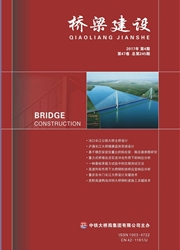

 中文摘要:
中文摘要:
In recent years, precast segmental concrete bridge columns became prevalent because of the benefits of accelerated construction, low environmental impact, high quality and low life cycle costs. The lack of a detailed configuration and appropriate design procedure to ensure a comparable performance with monolithic construction has impeded this structural system from being widely used in areas of high seismicity. In this study, precast segmental bridge column cyclic loading tests were conducted to investigate the performance of unbonded post-tensioned segmental bridge columns. One monolithic and two precast segmental columns were tested. The precast segmental column exhibited minor damage and small residual displacement after the maximum 7% cyclic drift; energy dissipation(ED) can be enhanced byadding ED bars. The experimental results were modeled by a simplified pushover method(SPOM), as well as a fiber model(FIBM) finite element method. Forty-five cases of columns with different aspect ratios, axial load ratios and ED bar ratios were analyzed with the SPOM and FIBM, respectively. Using these parametric results, a simplified design method was suggested by regressive analysis. Satisfactory correlation was found between the experimental results and the simplified design method for precast segmental columns with different design parameters.更多还原
 英文摘要:
英文摘要:
In recent years, precast segmental concrete bridge columns became prevalent because of the benefits of accelerated construction, low environmental impact, high quality and low life cycle costs. The lack of a detailed configuration and appropriate design procedure to ensure a comparable performance with monolithic construction has impeded this structural system from being widely used in areas of high seismicity. In this study, precast segmental bridge column cyclic loading tests were conducted to investigate the performance of unbonded post-tensioned segmental bridge columns. One monolithic and two precast segmental columns were tested. The preeast segmental column exhibited minor damage and small residual displacement after the maximum 7% cyclic drift; energy dissipation (ED) can be enhanced byadding ED bars. The experimental results were modeled by a simplified pushover method (SPOM), as well as a fiber model (FIBM) finite element method. Forty-five cases of columns with different aspect ratios, axial load ratios and ED bar ratios were analyzed with the SPOM and FIBM, respectively. Using these parametric results, a simplified design method was suggested by regressive analysis. Satisfactory correlation was found between the experimental results and the simplified design method for preeast segmental columns with different design parameters.
 同期刊论文项目
同期刊论文项目
 同项目期刊论文
同项目期刊论文
 期刊信息
期刊信息
